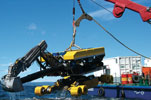
How does one go about preparing the ocean floor for a pipeline to extract natural gas from the enormous Ormen Lange gas field off the coast of Norway in the North Sea?
Nexans’ Spider remote operated vehicle (ROV) levels the seabed and clears a path for the pipeline, using National Instruments’ LabVIEW and CompactRIO to control the hydraulic systems.
Ormen Lange
In 1997, the Ormen Lange gas field was discovered off the western coast of Norway. It has the potential to produce around 20 billion cubic metres of gas each year. Ormen Lange, which means ‘the long serpent,’ is approximately 40 km long and 8 km wide and lies about 1000 m below sea level.
The gas field will be operational in 2007 and will be equipped with seabed installations at depths ranging from 800 to 1100 m. The gas will be transferred through a pipeline from production platforms to a processing plant at Nyhamna, Norway, and then exported via a 1200 km undersea pipeline to Easington on the east coast of the United Kingdom, and to other locations on the coast of continental Europe via a distribution centre on the island of Sleipner in the North Sea.
Extreme conditions at the site, including below-freezing temperatures, stormy seas, and strong underwater currents, put great demands on the tools needed to complete the project. Because of these conditions, the Ormen Lange gas field will not use conventional offshore platforms. Instead, wellheads on the ocean floor will be connected directly by pipes to the onshore processing facility at Nyhamna.
Spider ROV
In addition to the harsh environmental conditions, the topography of the ocean floor is very rugged. The pipelines must be routed through the rocky terrain in such a way that unsupported sections of pipe will not be vulnerable to damage. To solve this problem, Nexans has developed the Spider, a remote-controlled underwater excavator designed to prepare the seabed for pipe-laying on steep slopes and rocky terrain far below the water’s surface.
The Spider is used to level the seabed for placement of the pipeline and is controlled using newly developed 3D software, sensors on all movable parts of the machine, and a network of acoustic transmitters placed on the ocean floor. The 3D model of the seabed is updated in realtime using a LabVIEW human-machine interface (HMI) to show terrain changes. In addition, a remote-controlled underwater vessel with an echo sounder carries out a detailed daily inspection. The Spider can be controlled with 10-20 cm precision, even at a depth of 1000 m.
The software is used for presentation and control of the Spider, which is operated from a control room onboard a ship. The operator has a complete overview of the ROV through a number of different screens. Live video is also displayed from several cameras mounted on the Spider. The excavation process is displayed on the HMI front panel in a 3D ActiveX control. The 3D display shows a model of the seabed and, through a number of sensors on the Spider, a realtime image of the machine’s position. The machine and its grabber are controlled using an off-the-shelf joystick. LabVIEW reads the commands from the joystick through the joystick VIs and sends control signals over a fibre link to the Spider, even at depths of up to 1000 m.
Three distributed industrial control and acquisition NI CompactRIO systems, located in IP62 enclosures, are exposed to the rough marine environment for extended periods onboard Nexans’ ships in the North Sea. They perform heave compensation, winch, and power control and communicate with the main LabVIEW application. These algorithms run in realtime on CompactRIO.

The LabVIEW platform has helped Nexans develop a system that is easy to maintain due to the consistent programming paradigm for both HMI and embedded control, even in extreme conditions.
For more information contact National Instruments South Africa, 0800 203 199, [email protected], www.ni.com

© Technews Publishing (Pty) Ltd | All Rights Reserved